Most likely, you’re familiar with high-density lipoproteins (HDLs) and low-density lipoproteins (LDLs) and the risk that abnormal levels pose. But if you’re not familiar with the terms HDL 2b, LDL IVa, and LDL IVb, you probably need an update on how these subclasses can more precisely predict your patient’s risk.
Cholesterol: The good and the bad
The main purpose of lipoproteins is to transport cholesterol, triglycerides, and other insoluble fats through the blood. HDLs remove cholesterol from the blood vessels and transport it to the liver for excretion. This reverse cholesterol transport provides protection from heart disease and is the reason HDLs are called good cholesterol. A patient’s total HDL level is an independent risk indicator for coronary artery disease (CAD). Low levels (less than 35 mg/dL) are believed to increase the risk of CAD, and high levels (greater than 60 mg/dL) are considered cardioprotective.
The cholesterol carried by LDLs, however, can be deposited into the lining of the blood vessels. That’s why high levels of LDL, known as bad cholesterol, are associated with an increased risk of arteriosclerotic heart and peripheral vascular disease. Patients at high risk for heart and vascular disease should keep their LDL level below 100 mg/dL (and possibly below 70 mg/dL). Those at moderately high risk should keep their LDL level at or below 130 mg/dL, although in some circumstances, a target of 100 mg/dL might be recommended.
Understanding lipoprotein subclasses
With a new lab technique called segmented gradient gel electrophoresis (SGGE), lipoproteins can be subclassified to more accurately indicate cardiovascular risk. The HDLs have five subclasses: 2a, 2b, 3a, 3b, and 3c, but only one (2b) is cardioprotective.
HDL 2b is the most efficient form of HDL in reverse cholesterol transport, which vacuums the lipids from the endothelium. Thus, low levels of HDL 2b are associated with increased cardiovascular risk. Patients with low total HDL levels often have low levels of HDL 2b. When total HDL levels are between 40 and 60 mg/dL, levels of HDL 2b are minimal. However, when total HDL levels are greater than 60 mg/dL, levels of HDL 2b predominate, and efficient reverse cholesterol transport takes place, protecting the coronary arteries from disease. The other subclasses of HDL aren’t capable of reverse cholesterol transport and thus are not cardioprotective. Patients can increase their levels of HDL 2b by taking niacin supplements, but not by taking statins (HMG-CoA reductase inhibitors), such as simvastatin and lovastatin.
SGGE measures the size of LDLs and classifies them as small LDL trait or large LDL trait. Small LDL trait is associated with predominately small, dense LDL particles that greatly increase the risk of CAD, even if the total LDL level is normal.
The seven subclasses of LDLs from largest to smallest are LDL I, LDL IIa, LDL IIb, LDL IIIa, LDL IIIb, LDL IVa, and LDL IVb. The most commonly elevated subclasses are LDL IIIa and IIIb. The small LDL trait typically contains more than 22% of the LDL in these subclasses. And these particles are small enough to get between the endothelial cells and cause atheromatous disease.
The smallest forms of the LDL particles, LDL IVa and IVb, are associated with aggressive arterial plaques that make the blood vessels vulnerable to ulceration and vascular occlusion. Nearly all patients whose LDL IVa and IVb levels are greater than 10% of their total LDL level will suffer a vascular event within months. Total LDL levels can be lowered with statins, aerobic exercise, weight loss, and a low-fat, low-cholesterol diet.
Treatment guidelines
As with many newer tests, SGGE may not be available in your local area. But many blood samples are sent to the Berkeley HeartLab, Inc in California for analysis. This center provides not only the test results but also personalized treatment guidelines, diet recommendations, and an exercise program to help patients reduce their cardiovascular risk. For more information, please see www.bhlinc.com.
References
Pagana KD, Pagana TJ. Mosby’s Diagnostic and Laboratory Test Reference. 8th ed. St. Louis, Mo: Mosby/Elsevier; 2007.
Pagana KD, Pagana TJ. Mosby’s Manual of Diagnostic and Laboratory Tests. 3rd ed. St. Louis, Mo: Mosby/Elsevier; 2006.
Kathleen D. Pagana, PhD, RN, Keynote Speaker and Best Selling Author, is a Professor Emeritus at Lycoming College in Williamsport, Pennsylvania, and President of Pagana Keynotes & Presentations. She is the co-author of 18 books on diagnostic and laboratory testing, with translations in French, Spanish, Portuguese, and Chinese.


















